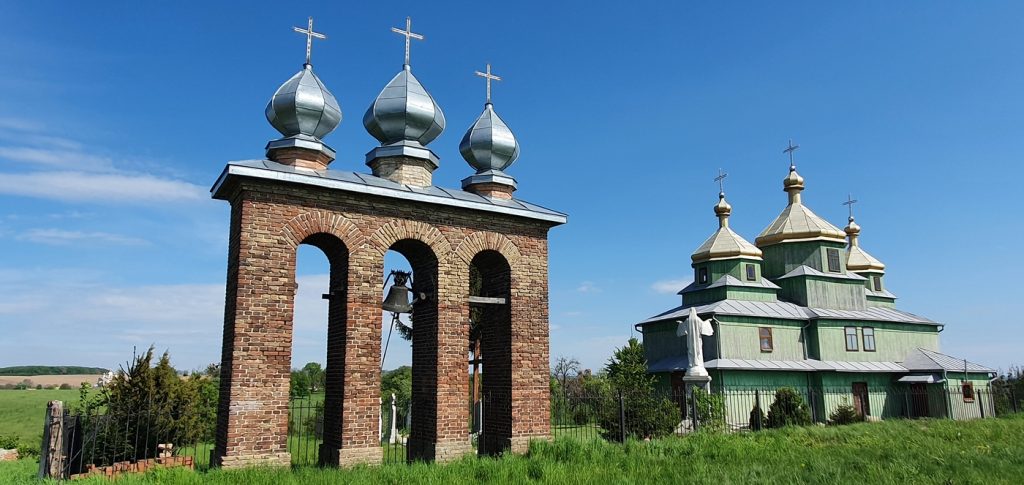The first mention of these villages in Lviv archival documents dates back to 1449. These villages belonged to the Belz principality, which belonged to the V. Volyn principality. They lay on the road between them. But in the 16th century, the German archaeologist Sakhen wrote that these settlements are very old. Teofil Kostruba, that during the so-called first Roman age in archeology (1-150 AD), a new culture of Germanic origin appeared in Belzchyna, which came with its carriers from the north.
Traces of their settlements are the so-called flared graves, located in our territories. And that’s probably why this area was of great interest to German archaeologists. Therefore, it is assumed that the name of Shmytki came from the German (forge). Near these villages there is a known late Paleolithic site (about 20,000 years ago).
Church in the village Shmitkovi was built in 1530. In 1629, the village Shmitkiv was burned by the Tatars, and the church was also burned. Roza Zlipskih in 1748. provided money for the construction of a church on her father’s estate. The church was built in 1755. It was wooden. of the Most Holy Mother of God. In 1879-1885 the church was restored again at the expense of Tomas Polyanovsky.
In July 1431 In the Belgian Land, including in our villages, a peasant uprising broke out, directed against the government, which was giving away many of the best lands to the Polish nobility, against the increase in taxes. The insurgents destroyed the estates of the nobility. Later, the royal army rushed to Belzka land, the rebel units were defeated.
In Ukraine, in 1648, the Ukrainian Cossacks’ war against the nobility began. The local population was waiting for the troops to arrive. B. Khmelnytskyi. In the fall of 1648 peasants from the village Moshkov, Shmitkova, Savchyna and Zavyshnia attacked the yard of the nobleman Samuel Polyanovsky, as evidenced by his complaint to the Belz court.
Since 1772 the villages came under the rule of the Austrian monarchy, the Polish magnates kept their possessions.
In 1875 The community of the villages of Shmitkova and Moshkova is building a school. The school was a 2-grade stage, 211 children studied there (Russian, as written in archival documents).
“Prosvita” was founded in Shmytkov in 1897. , which is a year earlier than in Sokal. At the opening on May 15, 1897. there were guests from Lviv who presented 53 books, 1 map and: portraits. People from the village were present. Sebecheva, Savchyna, Boryatina. The priest Fr. Mosevich, teacher Teodor Khmelnyk read the charter. There were 37 members in total, including 1 girl and 1 from Savchyn. The magazines Svoboda i Dilo and Svoboda were published. Already in 1899 the library had 162 books and 71 members, 41 men and 30 women. Enlightened people prepared holidays: “Enlighten”, “T. Shevchenko”, Mother’s Day, studied and put on plays, songs. A policeman was always present at the concerts. Loud readings of the books “Cold Ravine”, “Human Culture”, “History of Ukraine” were held.
In 1914 World War 1 began. Where the western Ukrainian lands became the arena of events. Sichov, which was joined by 17 residents of the villages, came forward to defend the autonomy and independence of Ukraine. From Shmitkov-Lutsyk – podhorunzhy. Lutsik Roman, Lutsik Stepan, Lutsik Shchasny, Myhal Petro.
Since 1927 in the village, the work of “Enlightenment” revived again. The following groups were organized: “Renaissance”, self-education (younger and older groups), “Native School”, the Union of Ukrainian Women, a loan office, “Zgoda” Cooperation, theater, choir and dance groups. There were more than 250 books in the reading room.
The village is located on the road between Belz and V.-Volynsky, so the roads in the village were paved. There were 2 mills.
26 residents of these villages studied at the Sokal gymnasium, it is not known how many studied at the Peremyshlyanska, the elder brother of V. Dyshkant, Mykhailo Dyshkant, graduated in 1946. became the general director of the Austrian National Bank in Vienna., Horbai Natalya, Hnatiuk Maria obtained a higher pharmaceutical education. Myhal Petro, Dyshkant Vasyl, Roman Krynytskyi – legal, Chave Olga, Dyshkant Yevhenii – pedagogical, Gura Volodymyr and Gura Yaroslav graduated from theological seminary and became priests. Lutsyk Yulian Andriyovych, graduated from the correspondence department at the Warsaw Higher School of Music, a music teacher at the Sokal Pedagogical School, and then at the Sokal Secondary School No. 1. In Rohatyn, Ivano-Frankivsk region, there is a museum of Mykola Vodonos, which has been in operation since 1927. the principal of a seventh-grade school. School No. 3 in Sokal is named after Vasyl Dyshkant, a native of this area.
In 1930 the Polish administration in Galicia believed that the growing wave of national elevation could be stopped by some radical actions or warnings. Therefore, by order from Warsaw, punitive repressions, known as “pacification”, began. Punitive expeditions arrived in Sokal region on September 27, 1930 and began searches. From October 8 to 12, military units were in Shmytkovo. They destroyed property in the reading rooms. 80 quintals of oats and 50 chickens were taken from the village as a contribution. Viit Onufry Hladky was beaten.
However, “Prosvita” resumed its work and in 1938 there were 340 books, 127 members. The circles became more active, the OUN organization was created. In 1936 they poured a symbolic rifleman’s grave for national heroes, arranged the graves of UGA riflemen, celebrated the anniversary of the glorious battles. In 1938 Vasyl Dyshkant was arrested.
Many students of the Sokal gymnasium entered the UPA

